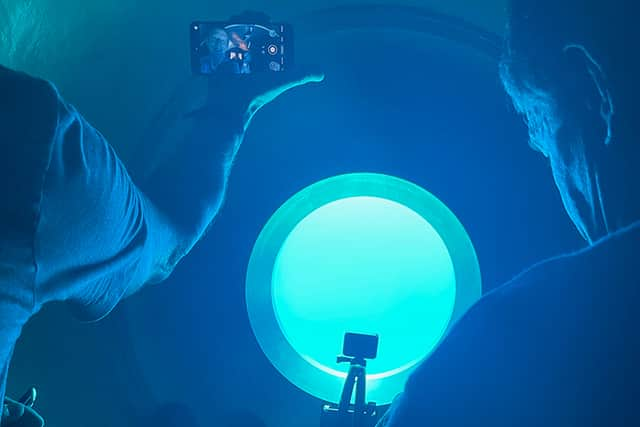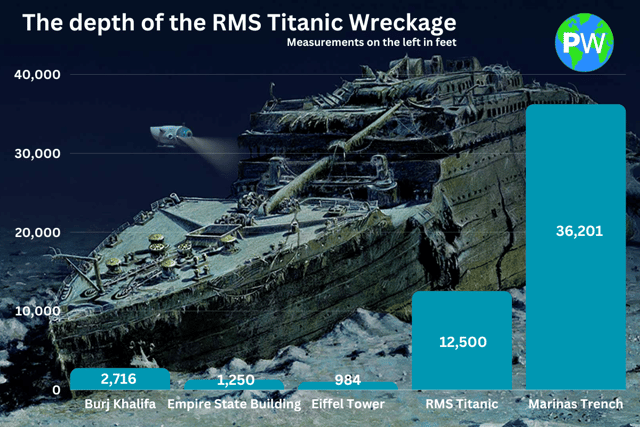Titan sub: how deep is the ocean - how far down is Titanic wreck - is it as deep as Mt. Everest is high?
and live on Freeview channel 276
The Titan submersible has been missing with five passengers on board, since it lost contact with the surface following a descent to the wreck of the Titanic on Sunday morning.
An immense rescue effort involving cutting edge ocean-exploring technology, and experts from all over the world has so far been unsuccessful in locating the vessel, which is believed to be lost thousands of metres below the surface of the Atlantic Ocean.
Advertisement
Hide AdAdvertisement
Hide AdThe difficulties of a search and rescue mission at such depths are compounded by a lack of natural light which cannot penetrate that far below the surface of the water, and the high water pressures, that mean that many submarines and other manned vessels cannot travel to such depths.
These challenges are monumental, even though the Titan submersible will not be at even half the depth of the deepest part of the world’s oceans.


How deep is the ocean?
The deepest part of the ocean is the Mariana Trench is the Pacific - it is around 11,000 metres (6.8 miles) below the surface. At this depth there will be no visibility as natural light does not penetrate below 1,000 metres.
Most submarines travel at a test depth (the depth they travel at in normal peacetime conditions) of between 300-400 metres. The Atlantic Ocean, where the Titanic wreck was found, is the second deepest of the world’s oceans, with a maximum depth of 8,376 metres. This is followed by the Indian Ocean (7,258 metres), Southern Ocean (7,236 metres), and Arctic Ocean (5,450 metres).
Advertisement
Hide AdAdvertisement
Hide AdThe first people to travel to the Mariana Trench, Don Walsh and Jacques Piccard did so in 1960, and until 2019 only one other person (Titanic director James Cameron in 2012) had done so. Since 2019, a further 24 people have travelled to the Mariana Trench - comparatively, more than 560 people have been to space since 1961.
How deep is the wreck of the Titanic?
The Titanic was travelling on its maiden voyage from Southampton to New York when it sank on 15 April 1912 after striking an iceberg in the middle of the Atlantic Ocean, hundreds of miles from the nearest coast.
The wreck was not discovered for more than seven decades - it was found by oceanography professor Robert Ballard in 1985. The wreck rests 3,800 metres below the water’s surface on the ocean bed.


At this depth, free diving to the wreckage is impossible, but extreme tourists and scientific experts have visited the site in specialised deepwater exploration vessels in the decades since its discovery. It is estimated that fewer than 200 people have seen the wreck up close - among them Titanic director James Cameron, who visited the wreckage 33 times.
Advertisement
Hide AdAdvertisement
Hide AdThe trips are expensive due to the nature of the specialised equipment and expertise involved - the passengers on the missing Titan submersible paid $250,000 for the dangerous journey.
Is the ocean deeper than Mt. Everest is high?
The deepest part of the Pacific ocean is in fact deeper than Mt. Everest is high. Everest, the pinnacle of challenges for mountaineers, is the world’s highest mountain above sea level. The summit is 8,849 metres (5.5 miles) high, but this is about 1.3 miles less than the Mariana Trench is deep.
Everest is higher than the Earth’s four other oceans are deep, and the Pacific Ocean has an average depth of 4,000 metres, less than half the height of the mountain. This means that there are only very few places on earth that are deeper than Mt. Everest is high.
Comment Guidelines
National World encourages reader discussion on our stories. User feedback, insights and back-and-forth exchanges add a rich layer of context to reporting. Please review our Community Guidelines before commenting.
